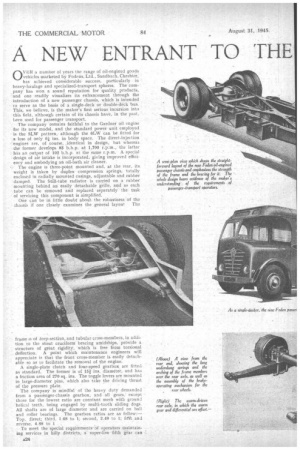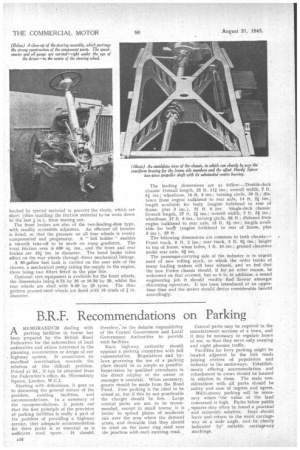A NEW ENTRANT TO THE ASSENGER-CHASSIS MARKET
Page 26

Page 27

Page 28

If you've noticed an error in this article please click here to report it so we can fix it.
OVER a number of years the range of oil-en,gined goods Ivehicles marketed by Fodens, Ltd., Sandbach, Cheshire: has achieved considerable success, particularly. in : heavy-haulage and specialized-transport spheres. The company has won a sound reputation for quality products. and one readily visualizes its enhancement through the introduction of a new passenger chassis, which is intended to serve as the basis of a single-deck or double-deck bus. This, we believe, is the maker's first serious incursion into this field, although certain of its chassis have, in the past, been used for passenger transport.
The company 'remains faithful to the Gardner oil engine for its new model, and the standard power unit employed is the 5LW pattern, although the 6LW can be fitted for .a lose of only 61 ins, in body space. The direct-injection 'engines are, of course, identical in design, but whereas the former develops 85 b.h.p. at 1,700 r.p:m., the latter has an output of 102 b.h.p. at the same r.p.m. A special design of air intake is incorporated, giving improved efficiency and embodying an oil-bath air cleaner.
• e The engine is three-point mounted and, at the rear, its weight is taken by duplex compression springs, totally enclosed in radially mounted casings, adjustable and rubber damped. The Still-tube radiator is carried on a rubber mounting behind an easily detachable grille, and as each tube can be removed and replaced separately the task of servicing this component is simplified.
One can be in little doubt abotit the robustness of the ehasSis if one closely examines the general layout The frame is of deep-section, and tubular-cross-members, in addition to the stout cruciform bracing amidships, provide a structure of great rigidity, which is free from torsional deflection. A point which maintenance engineers will appreciate is that the front cross-member is easily detachable so as to facilitate the removal of the engine.
A single-plate clutch and four-speed gearbox are fitted as standard. The former is of 15i an diameter, and has a friction area of 270 sq. ins. The toggle levers are mounted in large-diameter pins, which also take the driving thrust
of the pressure plate.
The company is mindful of the heavy duty demanded from a passenger-chassis gearbox, and all gears, except those for the lowest ratio are constant mesh with ground helical teeth, being engaged by multi-tooth sliding dogs. All shafts are of large diameter and are carried on ball and roller bearings. The gearbox ratios are as follow:— Top, direct; third, 1.68 to 1; second, 2.49 to 1; fin't and reverse, 4.38 to 1 .
To meet the special requirements Of operators Maintaining services in hilly districts, a super-low fifth gear can be incorporated as an extra, its ratio, as with the superlow reverse, being 9.6 to 1.
From the gearbox, the drive is taken to the worm-driven rear axle by a Hardy-Spicer two-piece propeller shaft, the self-aligning centre bearing embodying a large-diameter ball race encased in rubber.
The rear axle is fully floating, the axle casing being a onepiece steel-alloy drop forging; the high-tensile driving shafts are 2 ins, in diameter. The differential end of each shaft is formed into a toothed wheel, thus providing a large driving area and eliminating the wear which occurs with the usual splined shaft. The worm gear (7f ins, at centres) and differential are carried on ball and roller bearings, being underslung and off-set to give an uninterrupted floor line and to assist the body layout. .
The front axle is of 1 section and the hubs are drop stampings. The king-pin load is taken on taper-roller bearings.
The question of suspension—very important on a passenger chassishas received special attention. There are 11 leaves 3f ins, wide in the front assembly, and 14 leaves of the same width at the real, the eyes being stiffened by additional short " leaf ends " held by spring clips.
Luvax hydraulic shock absorbers are fitted to both front and rear axles.
As one of our pictures clearly shows, the steering gear is of most robust proportions, the housing being constructed in. an alloy which combines rigidity, strength and . lightness. The worm and segment are each mounted in large taper-roller bearings, and a feature of importance is that there is no backlash in the steering when the ,vehicle is travelling straight ahead.
The speedometer and oil tell-tale are mounted in the centre of, and slightly, above, the steering wheel, where they are easily readable but unobtrusive. The lamp switches, ammeter, etc., are carried in a control panel mounted at the right-hand side of the driver's seat. The head and side lamps are flush fitting with the front panel.
Powerful two-leading-shoe brakes of Foden design are used for the rear wheels. Uneven wear is avoided by employing facings of variable thickness in conjunction with special shoes, so that when all the automatic adjustment • has taken :place, the facings are -then, of even thickness— a useful economy feature. The facings are moulded and backed by special material to prevent the rivets, which are short (thus enabling the friction material to-be worn down to the last 1 in.), from tearing out.
The front brakes are also of the two-leading-shoe type, with readily accessible adjusters. An efficient oil booster is fitted, so that the pressure on all four wheels is evenly compensated and progressiso. A " hill holder" enables a smooth take-off to be made on steep gradients. The total friction area is 630 sq. ins., and the front and rear brakes are 16i ins, in diameter. The hand brake takes effect on the rear wheels through direct mechanical linkage.
A 30-gallon fuel tank is carried on the near side of the chassis, a mechanical pump taking the supply to the engine, there being two filters fitted in the pipe line.
Optional tyre equipment is available for the front wheels, the dimensions being 9.75 by 20 or 10.50 by 20, whilst the rear wheels are shod with 9.00 by 20 tyres. The discpattern pressed-steel wheels are fixed with 10 studs of 4 in. diameter.
The leading dimensions are as follow:—Double-deck chassis: Overall length, 25 ft.. 11iins.; overall width, 7 ft 51 ins.; wheelbase, 16 ft. 3 ins.; turning circle, 59 ft.; distance from engine bulkhead to rear axle, 14 ft. 24 ins.; length available for body (engine bulkhead to rear of frame, plus 3 ins.), 21 ft. 6 ins. Single-deck chassis: Overall length, 27 ft. 24 ins.; overall width, 7 ft. 51 ins,; wheelbase, 17 ft 6 ins.; turning circle. 56 ft.; distance from engine bulkhead to rear axle, 15 ft. 54 ins.; length available -for bocrir (engine bulkhead to rear of frame, plus 3 ins ), 23 ft.
The following dimensions are common to both chassis— • Front track, 6 ft. 2 ins.; rear track, 5 ft. 91 ins.; height to top of frame, when laden, 1 ft. 10 ins.; ground clearance under rear axle, 61 ins.
The passenger-carrying side of the industry is in urgent need of new rolling stock, to whioh the order books of many leading makers will bear witness, and we feel that the new Foden chassis should, if for no other reason, be welcomed on that account, but as it is, in addition, a sound engineering job it should readily find favour amongst , discerning operators. It has been introduced at an opportune time and the maker should derive considerable benefit accordingly.




















































